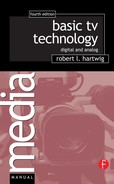This is not a TV production textbook but a book for TV production people. It doesn't deal with TV production techniques because there are already several fine books that cover those subjects. I see no reason to write what others have already done a better job of writing. Rather, this book deals with two interrelated subjects. I will show you how the various pieces of video equipment are integrated to form a complex video system. But to understand that, you must first have some knowledge of how the equipment works and what goes on inside it. I will explain that as well.
As TV equipment becomes more complex and sophisticated, it becomes more important to understand how that equipment works.This is especially true in the worlds of instructional and industrial TV, where one person may have to do it all.
Having an understanding of how the equipment and systems work gives you two distinct advantages. First, you will be more adaptable to different makes, models, and features. New buttons and knobs aren't as likely to intimidate you. Second, you can be more creative.You're not limited to what you have been shown, but can figure out new applications and how to solve problems for yourself.
One need not be an engineer or know advanced math and physics to understand the basics of how TV equipment works. After teaching much of this material for more than 30 years, I know that students with little or no math and science background can be taught to understand the equipment. However, students must realize that, because of their lack of background, they may not be able to get detailed answers to all of their questions.
Based on feedback from former students and their employers, I'm confident that the material in this book is the single most important body of material that my TV students receive. Many of them feel that it's even more important than experience using the equipment.
Since this book deals with television systems, it's difficult to understand some topics without the proper foundation. This book, then, uses the building block approach. Many topics rely on information from previous topics. Most of this book should be studied sequentially.
I've attempted to make this book as easy to read and understand as possible, but it should be recognized that few of us can learn TV production or TV systems just from a book. The best learning will take place if you use this book in conjunction with hands-on TV production experience. Everything from directing to shading to tape operation will help make the contents of this book more meaningful. I've tried to make the text clear, concise, and conversational.
With digital technology having taken over the video world, some may wonder why there is so much analog material in this new edition. That is a fair question. All of the digital equipment we have today was based on the analog systems that came before. It is difficult to understand the new systems without some understanding of earlier analog technology. Some readers may feel that I have included too much information on analog, but I always feel it is better to know too much rather than not enough. That is why I have left so much analog in this edition.
Since my main goal is to help people understand the concepts, I have, on occasion, simplified the facts and various theories somewhat in order to make the concepts a little clearer. I hope more knowledgeable readers will not oppose these changes.
